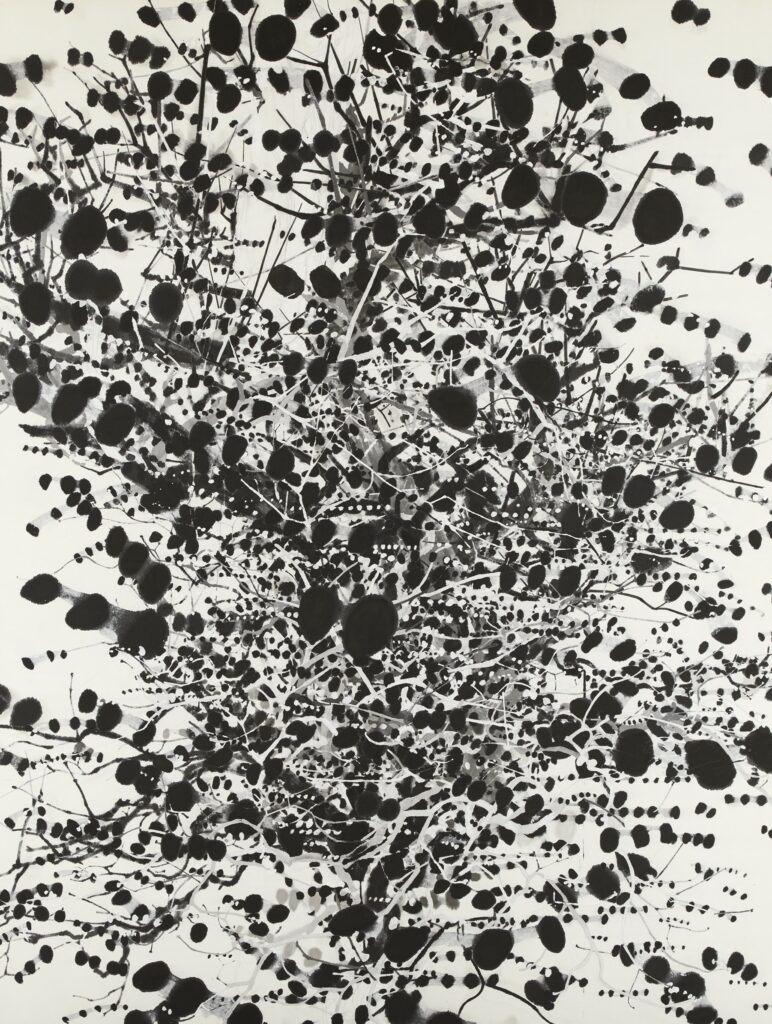Watch, Read, Listen
Recent Additions to the Collection MOMAT Collection Newsletter of the National Museum of Modern Art, Tokyo Azami Takako, Plum and Maple Trees , 2009
Back
Plum and Maple Trees
2009
Sumi and pigment on paper
265.0 × 200.0cm
Purchased FY2018
Azami Takako’s Plum and Maple Trees was newly acquired in fiscal 2018. Azami has been drawing attention as a painter who opens up new frontiers of possibility in nihon-ga (modern Japanese-style painting), and won the top prize at the 7th Higashiyama Kaii Memorial Nikkei nihon-ga Awards in 2018.
When she was a student at Tama Art University in 1988, Azami noted the effects of a failed application of dosa, a traditional material used to prevent bleeding. This experience led her to conduct various experiments and to arrive, in the late 1990s, at a technique of working on the backs of sheets of paper, using bled-through dots and spots to powerful effect. The artist says that when ink is layered on the front as usual, the color becomes dull, whereas when one applies accumulated layers on the back, only fresh, vivid shades of the ink appear on the front surface, creating a vibrant impression.
When one works on the back, the parts initially painted will bleed through the surface first, meaning that high-impact things in the foreground should be rendered first. A complex interplay of lines folding back on themselves is superimposed on pointillistic effects produced by sliding the brush over the paper and bringing it to a full stop, resulting in a surface that conveys the spatial expanse and multi-layered depth of the atmosphere, the light, and the rustling of leaves, and while far removed from a realistic, direct depiction of a tree, it captures and preserves initial impressions at the time of sketching. This approach does not allow for correction of errors, and requires the ability to skillfully control shading and bleeding of ink, but even the artist herself says that she cannot completely foresee how a painting will appear from the front, and on the contrary this bold embrace of chance outcomes and unexpected occurrences adds to the appeal of her work.
Azami produced Plum and Maple Trees after returning to Japan after studying in the United States for a year, and finding that back in her own studio, with high ceilings and considerable depth from front to back, she wanted to work with a vertical composition. The work depicts an old plum tree and a young Japanese maple just beginning to unfurl its buds in her garden, with complex intersections of the plum tree in the background and Japanese maple branches in the foreground illuminated by the sun, and is characterized by round white spots placed while sliding the brush horizontally. “Like the black ink spots and lines of the branches, the white areas against the black were also made from the reverse side, using a mixture of the traditional white pigment gofun, dissolved in nikawa resin, and acrylic dosa liquid. Dosa liquid alone would also work, but it becomes transparent when it dries, so I add some gofun. After I finish painting, I cover the entire back of the paper with gofun (to eliminate disparities between the white background and the white strokes I have applied, and because I feel it heightens the clarity of the black).”
The intricately entangled dots and brushstrokes brim with vitality, making Plum and Maple Trees an energetic image that fuses the power of inward concentration and outward diffusion, expressing the humming of air, light, and branches with a rich sense of organic life and amply conveying a wealth of new possibilities in ink wash painting.
(Gendai no me, Newsletter of The National Museum of Modern Art, Tokyo No. 635)
Release date :


